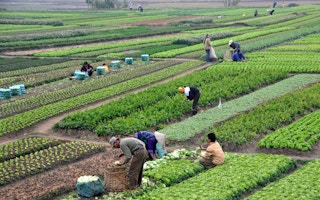About 4.7 million people in Southeast Asia fell into extreme poverty last year, even as countries are slowly recovering from the economic impacts of the Covid-19 pandemic, according to a new report by the Asian Development Bank (ADB).
To continue reading, subscribe to Eco‑Business.
There's something for everyone. We offer a range of subscription plans.
- Access our stories and receive our Insights Weekly newsletter with the free EB Member plan.
- Unlock unlimited access to our content and archive with EB Circle.
- Publish your content with EB Premium.
This means that 23.1 million, or 3.4 per cent of Southeast Asia’s 680 million inhabitants, are now living on less than US$1.90 a day — a global standard set by the World Bank. The region saw rapid economic growth in recent years, albeit from a lower base compared to many other parts of the world.
It’s the second year the extreme poverty rate has risen in Southeast Asia. The figure had fallen from 21.2 million in 2017 to 14.2 million in 2019, before rising to 18.4 million in 2020 in the first year of Covid-19, ADB told Eco-Business.
Meanwhile, job opportunities for the retrenched remain low. The pandemic is estimated to have cost about 9.3 million jobs in 2021, just slightly down from 10.6 million in 2020. The gap is expected to shrink to 4.1 million jobs this year. The report said that inactive workers risk becoming irrelevant if they leave the workforce for too long.
The double whammy of poverty and unemployment increases the likelihood of people falling into a vicious poverty cycle, according to report author and Asian Development Bank senior economist James Villafuerte.
“It impairs the ability of poor households to send their kids to school, thereby affecting the future welfare of younger generations,” Villafuerte said at the launch of the report.
“More worrisome is the fact that poverty and inequality destroys the foundations for social cohesion and growth,” he added.
“
Poverty and inequality destroys the foundations for social cohesion and growth
James Villafuerte, senior economist, Asian Development Bank
Uneven recovery
As it stands, the economic recovery is already uneven across Southeast Asia. The report found that countries with stronger manufacturing bases, as well as those with more oil and mineral resources, could recover better than others.
Indonesia, Malaysia and Singapore are expected to report healthy industrial output growth in 2021 at around 3 to 7 per cent. These countries largely kept Covid-19 at bay with successful vaccination programmes and provided prompt fiscal aid. Indonesia is the largest exporter of coal in the world, while Singapore is a global financial services and oil hub.
Other countries, such as Cambodia and Thailand, whose tourism and hospitality sectors withered, may only grow by up to 2 per cent. Myanmar is sharply in the red due to the military coup.
Overall economic output from Southeast Asia this year is expected to be over 10 per cent lower than if Covid-19 had not happened.
The exact figure is at the mercy of how the current Omicron wave pans out. If the virus dies out, 2022 output is expected to rise by about 5 per cent year-on-year. A protracted wave could wipe out 0.8 percentage points from the gains.
Key focus areas
The report called for more social assistance for groups hit harder by the pandemic, such as the youth, informal sector and migrant workers, women and the poor.
It also wants governments to better support small firms, which account for more than 97 per cent of all businesses in Southeast Asia. This support would include internet infrastructure upgrades and digital literacy training, as firms that could not hawk their goods online amid the pandemic lockdowns were found to be harder hit.
The report noted that Southeast Asia is vulnerable to natural disasters, which are becoming more frequent due to climate change. Floods and sea-level rise were identified as the key risks for the region in a global report on climate risk and adaptation last month.
“As countries emerge from the pandemic, it’s imperative that they don’t return to business as usual. They need to place themselves on a solid path to green recovery by putting in place policies that encourage the switch to cleaner fuels, that protect rivers and oceans, that promote biodiversity,” said ADB director general Ramesh Subramaniam. Private finance would be key to making such projects feasible, he added.
ADB said it will be revising its economic projections next month in the wake of Russia’s invasion of Ukraine, which has sent food and oil prices soaring worldwide. It said impacts on Southeast Asia should not be huge, but that global inflation may hinder the region’s pandemic recovery.

















